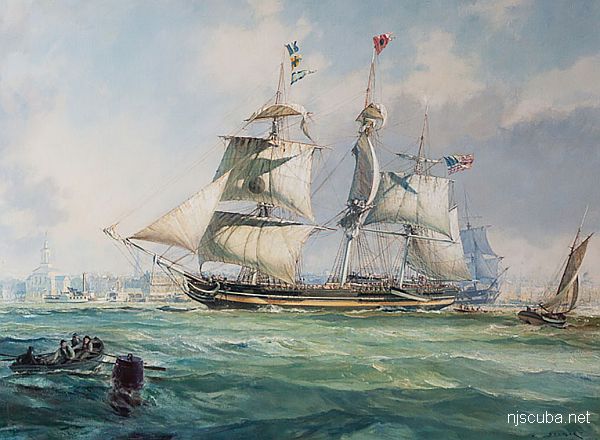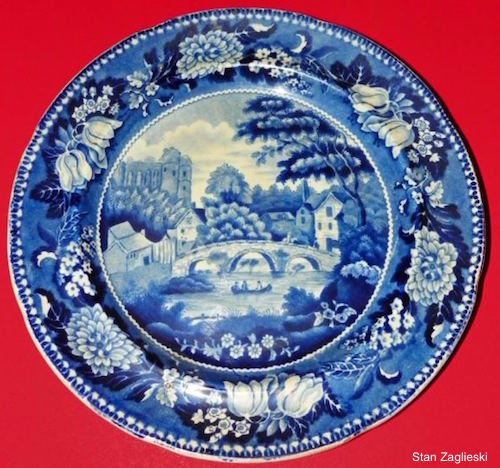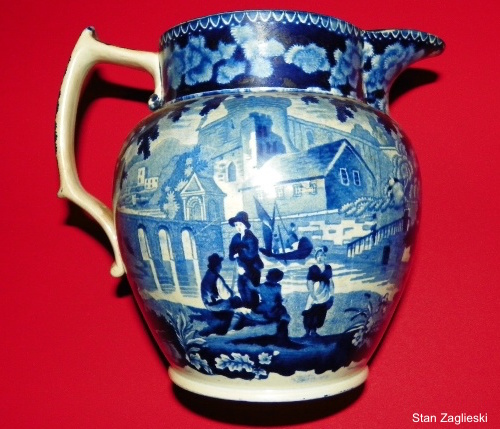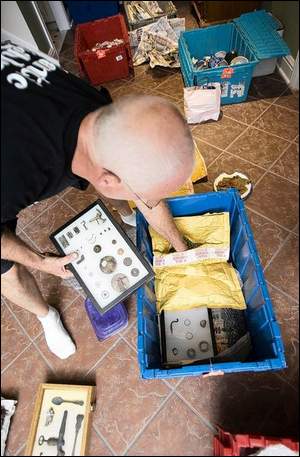Aurora

Aurora sailed for the Kermit Line.
- Type:
- shipwreck, sailing ship, USA
- Built:
- 1824, Bath ME, USA
- Specs:
- ( 106 x 22 ft )
- Sunk:
- Nov 20, 1827, ran aground in storm - 6 casualties
- Depth:
- 12 ft
Captain Taubman was in charge of the Aurora, sailing from Liverpool, England, to New York with 40 passengers and a cargo of $50,000 to $60,000 worth of china, coal, hardware and household goods. During a gale, the ship grounded about six miles south of Sandy Hook. Owned by Robert Kermit of New York's Kermit Line, the three masts soon fell, followed by the Aurora digging deep into the sand in about 11 feet of water.
The 40 passengers were all safely landed, and provided with accommodations in the tavern at the Highlands. After landing, the captain, mate, and six of the seamen, embarked in the longboat, but, the sea being rough, the seamen would not proceed, and preferred remaining on the wreck. The captain and mate succeeded in reaching the shore. On returning to the wreck after the gale subsided, two of the seamen were found lashed to the railings and drowned, the other four were washed overboard.


180 Years in the Deep
Finders hoping to display artifacts in area museum
Asbury Park Press 09/2/07
BY KIRK MOORE
STAFF WRITER
HIGHLANDS - After he'd cleared away the sand and silt, Joe Anthony knew they were on more than just a pile of slate shingles when he saw Gary Filippone's eyes go wide behind his mask. Buried within the shingles were china tableware - and not just fragments, like one glint of white stoneware that had attracted the divers to a spot on the shipwreck. There were stacks and stacks of unbroken teacups and saucers, plates and platters, some as perfect as the day they were crated by an English exporter 175 years before.
For five years a group of divers here have quietly excavated and documented the wreck of the Aurora, an American merchant ship that went down close to the Sandy Hook beach in a gale on Nov. 7, 1827. Now they're looking to find permanent homes for their collection, with, they hope, the Gateway National Recreation Area at Sandy Hook and the Twin Lights museum in Highlands. "The artifacts are going to get to a museum. I'd like to set up their museum out there at Sandy Hook with this stuff, if they'd have it, " said Anthony, of Highlands. These artifacts, he said, "are not going to be sold. They belong to the wreck."
The survival of the ship's remains and its cargo are remarkable, on a section of the seafloor scoured daily by tides pouring out of New York Harbor and often raked by storms that have threatened to batter through Sandy Hook itself. It was that pile of slate, quarried in Wales and bound for New York City rooftops, that ensured the Aurora would be the most unusual wreck on this coast, the divers say. "Nothing like this has ever been found in New Jersey, " said Filippone, of Highlands. "All this thing is missing is gold bars."
What the divers did find was a time capsule of commerce and technology from the 1820s. "It was right on the historical edge, between one-of-a-kind craftsmanship and mass production, " said diver Ken Harber of the Navesink section of Middletown. "It was like Home Depot: shingles, tools, hardware, dishes." Some 2,800 to 3,000 recovered artifacts include Staffordshire china by the famed Adams pottery makers of England, including patterns called Lady's Garden and Gables Farm that are sought by collectors today, Anthony said. There's a third, unidentified pattern in the haul, too. Doorknob and locksets, some still wrapped in paper, barrels of hardware, tools by the Marples family company of Sheffield, England, also were extracted from the hold. "During this time, England was sending over many, many manufactured goods, " said researcher Dan Lieb of the New Jersey Historical Divers Association, who helped the Highlands divers identify the Aurora wreck and research its history. "The Industrial Revolution was getting revved up, and America just couldn't make everything it needed."

The rarest finds were a sea captain's navigation instruments - a chronometer or navigational clock, and an octant, forerunner of the sextant that navigators use to calculate longitude and their position at sea. "It was the heart of the vessel's navigation system, " Lieb said. Finding an octant is a career jackpot for any wreck diver, partly because captains often took their prized instruments before abandoning ship. The Aurora octant is in exceptional condition with its lens frames, eyepiece, and whalebone ivory scales intact.
Research revealed there were two captains from the same shipping company on the Aurora's final voyage, Harber said. The octant probably was packed by the man along for a ride, he added. "We think it was part of the other captain's gear. He was heading for his next gig. He soon after took a ship out of Philadelphia." Both the Aurora's command captain, John Taubman, and his colleague, Charles A. Hearn, made it off the Aurora alive, with about 45 passengers and crew who rowed small boats through the furious storm to stagger ashore on Sandy Hook. Six sailors who tried to ride it out on the grounded ship were drowned or battered to death by the surf. Hearn himself died at sea, trying to bring a ship past Cape Horn at the tip of South America in 1846, according to the divers' research.
"The New Jersey coast at one point in the 1800s was considered to be one of the worst passages in the world, " Lieb said. "Insurers charged higher rates for ships going there. Sometimes they wouldn't cover it, and said, "If you go there, you're on your own.' "
Accounts of the wreck
Highlands researcher Cassandra Stafford helped the divers track down newspaper accounts of the Aurora's loss published in the Maryland Gazette and in a New York City publication. They say Taubman had loaded the ship and sailed from Liverpool on Sept. 24, 1827, and arrived off Sandy Hook six weeks later, the evening before the storm struck. On the next Wednesday morning, "The wind (was) blowing a violent gale from east- to east-southeast with a heavy rain and thick fog, " the Maryland Gazette story recounted. "The vessel being in imminent danger, Capt. Taubman cut away his three masts, and let go both anchors, to prevent her from going ashore, but in vain she struck about 5 miles south of Sandy Hook."
Taubman was able to hold a position at anchor until around 5 p.m., when on a falling tide the Aurora struck bottom, breaking some of its planks below the waterline. Taubman ordered 51 passengers and crew to get into the ship's two small boats to attempt a row through the thundering surf, but six sailors opted to take their chances staying with the ship. All of the others landed safely and were given shelter in the Highlands area, the divers say. According to the New York newspaper account, around 2 a.m. the following day the storm had subsided and local watermen set out in a small boat to recover the other six seamen. They found "four had been washed overboard, and the bodies of two men attached to the tattered rail, shockingly mangled and their very clothes washed away by the violence of the waves, " the New York report stated.
"This boat was seriously built. It was double-planked oak. With that load of Welsh slate, it pounded right into the bottom and the sand filled it in, " Harber said. More than a century after Aurora sank and was forgotten, local anglers knew it only as a hot spot for catching fish. In summer 2002, Gary Filippone went down to take a look.
Identifying the Aurora
Scientists say the Hudson River plume that shoots out of the harbor every day often creates stratified layers in the ocean water off Sandy Hook. Filippone remembers swimming down through murky brown that first day, before breaking into clear water. Below he saw the slate pile. "It opened up like a courtyard, " he recalled. "It was beautiful." In July 2002, Filippone was back with Anthony, and they began calling the spot the Shingle Wreck. "People have been fishing on this pile of slate forever. We found sinkers that are 50 years old, " Anthony said.
Anthony dives with an underwater scooter, a hand-held, battery-powered motor, and propeller that's as useful for blowing silt off a wreck as it is for towing a diver. After Filippone located the stoneware fragment, Anthony aimed his scooter's propeller down at the slates. "He and I are on top of the slate pile, and I see his eyes go wide, " Anthony recalled, still grinning at the almost ludicrous chances of such a find. They had located a trove of china inside the 55-foot long, 26-foot wide slate pile. "It was stacked inside the slate. That's how it survived." There was so much tableware the divers used milk crates hoisted by inflated airbags to get it all to the surface. They kept closed-mouthed about their project. "I said, "We can't let this get out of control, ' " Filippone said.
They sweated out close calls, once finding a beach replenishment sand dredge anchored over the wreck, and another time diving amid fishermen drifting for summer flounder. "I was down there with hundreds of hooks in the water, " Filippone said with a laugh. But they didn't tell anyone for fear of setting off a rush of intruders who would clean out the wreck. In time, the divers would learn the history of the Aurora - a young ship at the time of its death, built in Bath, Maine, in 1824 as a full-rigged, three-masted ship 106 feet long and 22 feet wide. Some of the hardware they recovered was stamped by an import company that had been in business for only two years in the mid-1820s, and some china indicated a similar time frame. But the artifact clues stopped there.
"This ship was from Bath. But it threw us for a loop. To this day, we haven't found anything American on the ship. Everything was British, except for a wine bottle seal, which was French, " Harber said. "They weren't able to come up with a single candidate, " said Lieb, whom Filippone approached three years ago for help in identifying the wreck. But the divers had found an early piece of evidence - an iron knee brace, a connector for ship's ribs that was characteristic of Maine-built ships of the period, Lieb said. Within weeks, a search of records named the Aurora as a possibility. The final proofs were tiny: captain's stamps, used to put official company impresses on letters and documents. The divers had found two, one with the letters JT for John Taubman, and C.H. Hearn for the ill-fated Hearn. "That clinched it, " Lieb said.
They learned the Aurora had been owned by a shipping company called the Kermit Line that was very active in that early Industrial Revolution trade. Filippone has friends with a family home in Florida, and he gave them a china set to bring to an Antiques Roadshow there, the traveling antique appraisal that's seen on public television. An appraiser was impressed by one Aurora piece. "Your family must have taken very good care of it over the years, " he said. "It was found at the bottom of the ocean, " they told him. There's no windfall fortune to be had from all that china, Anthony said. One thing the divers learned is how much the market for antique Staffordshire ware values perfection above all else, even a good shipwreck story.
Beyond all the pretty blue plates, the divers' most tantalizing find was a rather nondescript medallion - a cheap unofficial medal, really, that was given to veterans of the Battle of Trafalgar, fought in 1805. The British Admiral Lord Nelson's victory over a combined French and Spanish fleet settled the sea power side of the Napoleonic Wars, and the medallion likely belonged to one of the Aurora's older sailors, the divers say.
On that last trip across the Atlantic, life on board the Aurora would have been not unlike the scenes in the Russell Crowe film "Master and Commander, " with its depiction of early 19th-century life at sea, said diver John Kohnow of Yardley, Pa. "When you see "Master and Commander, ' in those scenes where they're eating in the captain's quarters, you see the platter racks, " Kohnow said, hefting one stoneware piece molded in England and fit for a roast bird or beef. "When Russell Crowe is showing the younger officers how to navigate, it's an octant they're using."
From their docks and houses in Highlands, the divers can look out to Sandy Hook and easily imagine the Aurora jammed into the shoals. Filippone said their investigation revealed something else: "A lot of times, you find more adventure in your own backyard than traveling around the world."

Questions or Inquiries?
Just want to say Hello? Sign the .